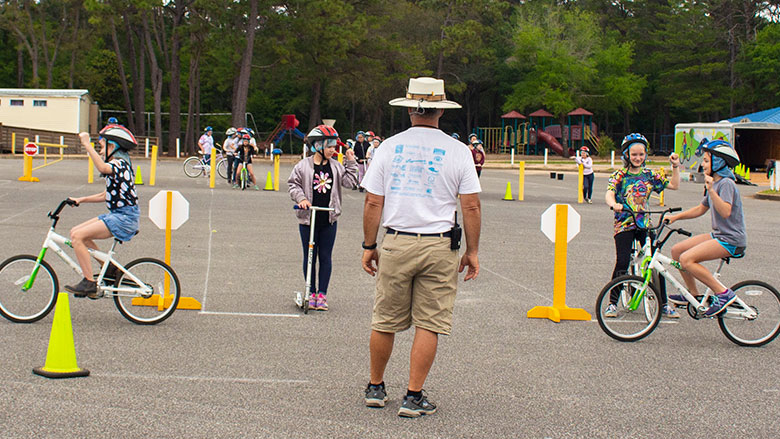As the summer approaches, parents of elementary school-aged children are anticipating their children spending a lot of time outside; activities may include walking and riding bicycles. For obvious reasons, this may cause concern for some parents. Fortunately, the 3rd–5th graders of Shalimar Elementary are well trained in pedestrian and bicycle safety during their physical education classes. A grant from the Florida Department of Transportation (FDOT) and the Safe Routes to School Program provides the helmets and bicycles for the students to ride. Every year, Coach Keith Oliver teaches a unit in bicycle safety, calling it a “Mini Driver’s Education” class.
Before hitting the road, students spend time learning the basics. Starting when students are in kindergarten, Coach Oliver goes over pedestrian safety, stressing to students to stop at the edge of a road and look left, right, and left. Students are also taught how to cross at an intersection and how to safely cross in front of a school bus. Students in 3rd, 4th and 5th grades are taught more advanced concepts such as the four basic hazards that bike riders need to know, visual, surface, stationary, and moving hazards. An example of a visual hazard is the sun. It can hinder the bicyclist from seeing obstacles around them, as well as keeping them from being seen by others. An example of a surface hazard is water on the road, the worst of all the surface hazards. Standing water will hide all other debris that is on the road, and moving water can knock the rider off the bicycle. Automobiles are a common example in three of the four hazards. This is expected for there are more cars on the road than bicycles.
One of the first lessons taught in Coach Oliver’s class is how to choose a helmet and bicycle that fit properly for each student. Oliver reminds students and parents that it is not safe to choose a bicycle that a child can “grow into.” After students have been assigned helmets and bicycles, the outside riding lessons begin. Coach Oliver created a riding range complete with cross traffic, left and right turns, and stop signs, which is used in most of his outdoor lessons. During outdoor lessons, the students are taught the importance of looking ahead for hazards. Many of them find out quickly how hard it is to stop on a dime, and learning to scan ahead for hazards can increase their reaction time for a shorter stopping distance. The students usually discover on their own that it is much easier to ride with traffic. The “old school” way was to ride facing oncoming traffic but since bicycles are considered vehicles, a bicyclist should obey the same traffic laws as other vehicles.
Other riding lessons include learning how to dodge a surface hazard, scan to the rear looking for other vehicles, and right-hand and left-hand turns. While practicing right and left turns, the students create their own traffic. They learn quickly that running a stop sign may cause them to hit crossing traffic. Most of the lessons are taught on a riding course located on the bus ramp. The 5th graders are allowed to ride in the front of the school, which gives them an opportunity for real-time lessons. They are required to watch for cars coming into and backing out of the parking lot.
When asked why he feels it is important to teach bicycle safety, Coach Oliver replied, “Riding bikes during PE is like a mini Driver’s Ed class for the students. The skills they learn in my class will mirror what they will need to know when learning to drive a car.” Adreanna, a 4th grader, said what she liked most about riding bikes during PE was, “It is a good way to be physically active and a good way to learn the rules of the road.”













